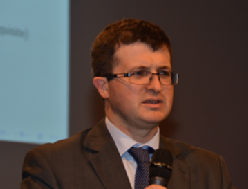Invited Speakers
Hamido Fujita
Professor and Director of Intelligent Software Systems, Iwate Prefectural University, Japan
http://www.fujita.soft.iwate-pu.ac.jp/
Editor-in-Chief: Knowledge-based system, Elsevier
http://www.journals.elsevier.com/knowledge-based-systems
Co-Editor-in-Chief: Applied Intelligence, Springer
On New directions in Machine Representation Learning for Biometrical Analytics
Abstract
Discovering patterns from big data attracts a lot of attention due to its importance in discovering accurate patterns and features that are used in predictions for accurate biomedical information for better security. Biometrics provides a suitable robust authenticated identification based on feature extraction for verifiable data. Physiological Analytics are either morphological or biological. Fingerprints, hand or face shapes, facial analysis, vein pattern, iris and retinal feature in the eyes, walking steps patterns, are all different pattern morphological biometrics for authentication purposes used in pattern recognition, Behavioral analytics is also another type of biometrics-based authentication, like voice recognition, signature dynamics, keystrokes, gait, sound of steps and gestures, etc., and all these are used to measure individual behaviors and rhythm, for example, stress or other types of behavior related to aggressive acts in a bank or in a crowd. All these different types of biometrics have different reliability for a variety of purposes. This talk is to highlight new direction on the state of the art on Physiological Analytics (PA) due to its stability in providing better authentication, not affected by stress like in the behavioral ones. PA provides techniques to extract patterns (features) from faces based data, or fingerprint data based analytics to extract features related to features in the face or palm veins or geometry in the hands, or iris recognition, and retina. In this talk, I will focus on face recognition and fingerprints analytics, and its current state of the art. The challenges in big data analytics for facial analytics and fingerprints based data are of high dimensionality and complexity in data representation for feature extraction. Also, it has a class imbalance in the multiclass classification problem. Conventional approaches in machine learning are not providing accurate authentication process in robust feature extraction for objects like beard or hair color change. In this talk, I will present the current state of the art and focus on face recognition main problems in deep learning and multiclass classification in feature selection. Several problems and solutions are to be provided with examples.
Biography
He is Professor at Iwate Prefectural University (IPU), Iwate, Japan, as a director of Intelligent Software Systems. He is the Editor-in-Chief of Knowledge-Based Systems, Elsevier of impact factor (4.528) for 2016. He received Doctor Honoris Causa from O’buda University in 2013 and also from Timisoara Technical University in 2018, and a title of Honorary Professor from O’buda University, Budapest, Hungary in 2011. He received honorary scholar award from University of Technology Sydney, Australia on 2012. He is Adjunct professor to Stockholm University, Sweden, University of Technology Sydney, National Taiwan Ocean University and others. He has supervised PhD students jointly with University of Laval, Quebec, Canada; University of Technology, Sydney, Australia; Oregon State University (Corvallis), University of Paris 1 Pantheon-Sorbonne, France and University of Genoa, Italy. He has four international Patents in Software System and Several research projects with Japanese industry and partners. He is vice president of International Society of Applied Intelligence, and Co-Editor in Chief of Applied Intelligence Journal, (Springer). He has given many keynotes in many prestigious international conferences on intelligent system and subjective intelligence. He headed a number of projects including Intelligent HCI, a project related to Mental Cloning as an intelligent user interface between human user and computers and SCOPE project on Virtual Doctor Systems for medical applications.
Sebastien Marcel
IEEE Senior Member
Idiap research institute
Head of the Biometrics Security and Privacy group
Senior Member of the Research Staff http://www.idiap.ch/~marcel
Swiss Center for Biometrics Research and Testing http://www.biometrics-center.ch
Biometric Spoofing and Anti-Spoofing aka Presentation Attack Detection
Abstract
In Biometrics, presentation attacks (also coined as spoofing) are now widely accepted to be of two kinds: impersonation, where the attacker attempts to impersonate the victim, and obfuscation, where the goal of the attacker is to avoid being recognised. The vulnerability of state-of-the-art recognition to presentation attacks (PA) have been already demonstrated and presentation attack detection (PAD) is now a growing research topic. In this talk we will review PA techniques published in the literature for face but also for several biometric modalities, their vulnerability assessments and introduce several PAD methods.
Biography
Dr Sébastien Marcel ( http://www.idiap.ch/~marcel — IEEE Senior Member ) received the Ph.D. degree in signal processing from Université de Rennes I in France (2000) at CNET, the research center of France Telecom (now Orange Labs). He is currently interested in pattern recognition and machine learning with a focus on biometrics security and privacy. He is a senior researcher at the Idiap Research Institute ( http://www.idiap.ch/en ), where he heads the Biometrics Security and Privacy group ( http://www.idiap.ch/en/scientific-research/biometrics-security-and-privacy ) and conducts research on face recognition, speaker recognition, vein recognition and presentation attack detection (anti-spoofing). The Biometrics Security and Privacy group prioritizes reproducibility in research and make freely available the signal-processing and machine-learning toolbox Bob ( https://www.idiap.ch/software/bob/ ) and the BEAT platform ( https://www.beat-eu.org/platform/ ). He is a lecturer at the Ecole Polytechnique Fédérale de Lausanne ( http://www.epfl.ch ) where he is teaching a Doctoral course on “Fundamentals in Statistical Pattern Recognition” and at the Université de Lausanne ( http://www.unil.ch ) where he is teaching a Master course on « Biometrics ». He was VP Conferences of the IEEE Biometrics Council. He was Associate Editor of IEEE Signal Processing Letters, Associate Editor of IEEE Transactions on Information Forensics and Security, a Guest Editor of the IEEE Transactions on Information Forensics and Security Special Issue on “Biometric Spoofing and Countermeasures”, and Co-editor of the IEEE Signal Processing Magazine Special Issue on “Biometric Security and Privacy”. He is also the lead editor of the Springer “Handbook of Biometric Anti-Spoofing” (Edition 1 and 2). He was the principal investigator of international research projects including MOBIO ( EU FP7 Mobile Biometry — http://www.mobioproject.org ), TABULA RASA ( EU FP7 Trusted Biometrics under Spoofing Attacks — http://www.tabularasa-euproject.org ) and BEAT ( EU FP7 Biometrics Evaluation and Testing — https://www.beat-eu.org ). Finally, he is the Director of the Swiss Center for Biometrics Research and Testing ( http://www.biometrics-center.ch ) at Idiap.

